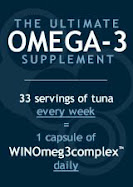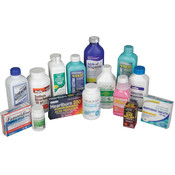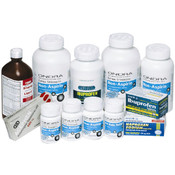Market studies are showing that the demand for ‘functional’ energy drinks continues to growing! This expanding market trend is timed perfectly with the release of the new sugar-free Winrgy®, a new energy drink loaded with vitamins, minerals and amino acids. This low-calorie, low-carb drink delivers instant, long-lasting energy and mental performance without the crash or jitters.Winrgy®, distributed by
Vitaelin Nutraceuticals (4960 South Gilbert Rd, Suite 1-286, Chandler, Arizona, USA +1 480 626 7218), is the answer to growing consumer demand for more natural energy drinks and is geared toward an 18-35 year-old demographic. Along with caffeine, vitamin C, B6, vitamin E , thiamin riboflavin, niacin and folate (as folic acid), the functional energy drink contains taurine (2-aminoethanesulfonic acid), which is an essential amino acid found in many of the body's organs to aid digestion.
A growing trendWhile other drink segments, such as bottled water and carbonated or ‘fizzy’ soft-drinks are fatigued and showing saturation or even decline, the market for ‘functional’ and ‘energy’ drinks is not affected and rapidly growing. Data compiled by
Zenith International Ltd (7 Kingsmead Square, Bath BA1 2AB United Kingdom, phone +44 (0)1225 327900), a European drinks consultancy based in England, shows a market valued at €3.76 billion ($ 5.4 billion) in 2007, with growth at 11 per cent over 2006 for a total of 487 million litres. Although consumer spending is down in most western lands, analyst at Zenith expect that sales of ‘functional’ and ‘energy’ drinks will grow approximately 8% for the next five years, approaching a total volume of nearly 700 million litres by 2012. The prognoses is supported by
Mintel International Group Ltd (18-19 Long Lane, London EC1A 9PL, United Kingdom, phone +44 (0)20 7606 4533), a privately owned market research firm, which predicts this continued growth to reach €6.97 billion ($10 billion) of total sales by 2010.
Today’s most national markets for ‘energy’ drinks are dominated by
Red Bull, (Red Bull GmbH, Am Brunnen 1, A-5330, Fuschl am See, Austria, phone +43 662 6582 0) which is sold in more than 140 countries in the world and holds about 60% of the total market of energy drinks. While analysts predict an increase in completion, they don’t expect to see a major shift in brand loyalty or market domination.
Traditional soft-drinks manufacturers are turning to 'added functional ingredients' as a means of enlivening the sometimes tired appearance of their mainstream soft-drinks. As Goliaths they are looking to the Davids of the industry, the smaller, emerging, soft-drinks manufacturers who already have embraced an array of ‘functional’ and ‘energy’ options in order to differentiate their products. More than ever, with health and wellness being the driving factor, ‘functional’ and ‘energy’ drinks are entering a new, uncharted, area.
What are ‘functional’ drinks?
To date, there is no real, universally accepted, definition of the term ‘functional’ drinks. However, the generally held idea is that ‘functional’ drinks are beverages fortified with a hodgepodge of nutritional and dietary supplements such as vitamins and minerals, mild stimulants such caffeine, antioxidants, amino acids, and herbal extracts like gingseng, ginko biloba, guarana, yerba mate, green tea polyphenols, kola nut extract and other ingredients and that they may offer specific health promoting benefits and/or disease preventing properties over and above the usual nutritional value. Products within this category are given a number of names including sports-drinks, isotonic-drinks, hypotonic-drinks, energy-drinks, functional-drinks, stimulant- or power-drinks, tonics or elixirs.
But the first ‘functional’ drinks did not resemble the soft-drinks we associate today with ‘functional’ drinks. In the early 1930s Dr Minoru Shirota, then working in the microbiology lab at
Kyoto Imperial University's School of Medicine (Yoshida-Honmachi, Sakyo-ku, Kyoto 606-8501, Japan, phone +81 75 753 2047), succeeded in culturing and utilizing lactic acid bacteria. Based on this culture, Shirota started the production of his yogurt-like probiotic-drink containing Lactobacillus casei strain shirota which he marketed under the brand name Yakult (today produced and marketed by
Yakult Honsha Co., Ltd., 1-19 Higashi Shimbashi 1-chome, Minato-ku, Tokyo, Japan, phone +81 33 574 8960).
Since then, over a dozen brands of ‘functional’ drinks containing calcium, iron, amino acids, b-carotene, fiber, hangover cures, energy boosters or ingredients to help joint flexibility, have been developed by carefully marrying health and medicine. From the 1930 onwards, many drinks and foodstuffs around the world were fortified with Vitamin D until health authorities in the 1950s limited Vitamin D fortification to milk and read-made breakfast cereals alone, only to allow Vitamin D fortification of a broader range of products again in the late 1980s.
Anti flu beveragesDue to the fact that the potency of vitamins erodes over time, ‘functional’ drinks generally have a relatively short shelf life. To combat these effects Degussa FreshTech Beverages LLC (735 N Water St Suite 1128, Milwaukee, WI 53202-4105, Phone +1 262 549 2517) and
Ball Packaging Europe GmbH (formerly Schmalbach-Lubeca, Kaiserswertherstraße 115, Ratingen, D-40880, Germany, phone: +49 2102 130 0) jointly developed the ground-breaking ‘FreshCan®’ technology. This new technology enables vitamins, minerals or probiotic additives to be stored in a dry state inside a can until the consumer opens it. Today, New York based
Brain-Twist Inc. (535 W 34th Street, New York, NY 10001-1303, phone +1 212-594-6772) offers this new technology for their immune boosting beverage Defense Effervescent Supplement or ‘Defense’, a beverage specifically designed to combat flu season.535 W 34th St, New York, NY 10001-1303 535 W 34th St, New York, NY 10001-1303 So far, the drink is only available in
7-Eleven stores (2065 Sidewinder Dr, Park City, UT 84060, phone +1 435 645 9595) in North America.
How did we get here?
The history of ‘functional’ and ‘energy’ drinks is quite interesting. Although not marketed as such, the granddaddy of today’s ‘energy’ drinks is probably Irn-Bru, first produced by
A.G Barr Plc. (Westfield House, 4 Mollins Road, Westfield, Cumbernauld, North Lanarkshire, G68 9HD, Scottland, phone +44 (0)1236 852400) in 1901, under the name Strachan's brew and later (1946) changed in Irn-Bru because the drink was not really brewed.
Another early brand of ‘energy’ drink can be found in England.
Lucozade produced by pharmaceutical giant
GlaxoSmithKline Plc. (980 Great West Road, Brentford, Middlesex, TW8 9GS, United Kingdom, phone +44 20 8047 5000) was first developed in 1927 by a Newscastle Chemist searching for a source of energy for the ‘sick and infirm’. After several years of experimenting, Glucozade, a glucose syrup containing drink, was introduced as a special drink for ‘aiding the recovery’ and only available in hospitals. In 1929 the name was changed to the more recognizable ‘Lucozade’. Later, when popularity grew, it also became available outside hospitals and today it is one of the strongest brands sold in England.
While select number of energy stimulating drinks were developed and marketed around the world in the early part of the 20th century, the real advent of ‘energy’ drinks started in Japan were the most popular energy drinks date back to the late 1950s and early 1960s. Before crossing over to the ‘west’ energy drinks had been enthusiastically consumed in Japan and other Asian countries for many decades. Most of the then popular original energy drinks bear little resemblance to modern soft drinks as they were generally sold in small brown glass medicine bottles by pharmacies. Called ‘genki drinks’, these drinks were primarily marketed to the hard working ‘salarymen,’ the overworked and underpaid office clerks for which Japan is famous.
Among the first companies to enter the energy drinks market was
Taisho Pharmaceuticals Co., Ltd. (24-1, Takada 3-chome, Toshima-ku, Tokyo 170-8633, Japan, Phone +81 3 3985 1111). In 1962 Taisho developed its drink concept by combining taurine with vitamin B to create Lipovitan D. Today, this brand is with almost a 60% share, still dominating the domestic Japanese market, closely followed by Oronamin C, a carbonated ‘fizzy’ health drink containing isoleucine and other essential amino acids as well as vitamin B2, B6 and C, produced by
Otsuka Pharmaceutical Company Ltd. (2-16-4 Konan, Minato-ku, Tokyo 108-8242, Phone: +81-3-6717-1400). More recently Taisho developed special low-calorie versions for women and vitamin-fortified energy drinks for children.
The Asian ‘energy’ drinks remained quite unknown in the western world until Jolt Cola, made by The Jolt Cola Company, now
Wet Planet Beverages (Rochester, New York 14625 USA, Phone +1 585 381 3560), was introduced in the United States in 1985. This high caffeinated cola drink was developed by C.J. Rapp, a beverage inventor, and marketed with the initial slogan ‘All the sugar and twice the caffeine’ to promote vigilance and wakefulness.
In Europe, the concept of energy drinks was pioneered by the Austrian company of
S. Spitz GmbH., (Fiedlerstraße 10, POB 102, A-4041 Linz, +43/732/70 97-0, a privately held company engaged in manufacturing non alcoholic drinks, syrups, liqueurs, schnapps, brandy, special spirits, ketchup, mustard, mayonnaise, wafers and rolls) when the company introduced
Power Horse), a revitalizing energy drink designed to increases mental and physical power, in the spring of 1994.
But today’s dominating energy drink, Red Bull, was developed just a few years earlier, in 1987, when Austrian entrepreneur Dietrich Mateschitz and his Thai business partners Chaleo and Chalerm Yoovidhya founded Red Bull GmbH and created the ghastly tasting berry-flavored energy drink, marketing it to young people using cheeky advertising and extreme sports sponsorships. Spiked with taurine and glucuronolactone the 8.3-ounce can contained 80 milligrams of caffeine, more than double the dose found in an 12-ounce can of regular Coca-Cola (40 mg/330 ml can), but with less calories per serving (110 vs. 140). The high concentration of caffeine (similar to that found in an average cup of brewed coffee, typically 100 mg/250 ml cup, but 72 mg for a U.S. regular 6 fluid ounces cup of coffee), glucose, sucrose, taurine and glucuronolactone was supposed to increase metabolism, thereby improving the drinkers’ concentration, energy, and endurance.
Red Bull’s Asian Origin
Mateschitz and his partners based their drink on the Krating Daeng, a very sweet, non- carbonated syrupy tonic produced by T.C. Pharmaceuticals Industries Company Ltd (39/13 Moo 8 Ekachai Rd., Bangkok, 10150, Thailand, +66 02 415 2258) and sold in pharmacies in Thailand as a revitalizing agent. Interestingly enough, Krating Daeng itself was based on the Japanese ‘energy drink’ Lipovitan D.
Red Bull was an instant hit in Austria and sales continued to rapidly grow. Marketed as ‘to combat mental and physical fatigue’, Red Bull was soon launched in other European countries. Initially, the drink was banned in France and Denmark because of health concerns over the high caffeine level and the use taurine. Today, Red Bull with its enticing brand motto ‘Red Bull vitalizes the body and mind’ has taken almost half of the US market for energy drinks and up to 80% in some other western countries.
To combat the critique for the negative effects of taurine, Red Bull replaced it with arginine in France. Arginine is a semi-essential amino acid linked to enhanced immunity, the release of the Human Growth Hormone (HGH), greater muscle mass, rapid wound healing, increased sexual potency, and helping to reverse atherosclerosis.
David vs. Goliath
Major beverage companies, including PepsiCo, Coca-Cola and MillerCoors, have tried to duplicate the success of Red Bull, Power Horse, Jolt Cola and other energy drinks developed by smaller and more innovative companies. These attempts did not always succeed.
For example, In 1995
PepsiCo Inc.(700 Anderson Hill Road Purchase, NY 10577, USA, phone +1 914 253-2000) launched Josta, a ‘high-energy drink’ with guaraná and caffeine and a predominately fruity flavor and a hint of spice. After a flawed market introduction and a change in corporate strategy, PepsiCo discontinued the drink in 1999. Today, PepsiCo owns not only the established
Mountain Dew brand, but also a variety of brands, including the AMP energy drinks, dubbed as Pepsi's first real entry into the energy drink market, that taste like Mountain Dew with a bit more bite, and Jeff Gordon 24 Energy, a brand new energy drink uniquely formulated for race fans and energy drinkers.
MillerCoors (MillerCoors LLC, 3939 West Highland Boulevard, Milwaukee, WI 53208, USA), a joint venture between
SABMiller Plc. (One Stanhope Gate, London W1K 1AF, England, phone +44 20 7659 0100) and
Molson Coors Brewing Company(1225 17th Street, Suite 3200, Denver, CO 80136, USA, Phone +1 303-277-3500), which owns
Sparks, a caffeinated alcohol beverage with a blend of caffeine, taurine, guarana and ginseng extract, has made number of questionable decisions and downright marketing blunders with their alcohol/energy hybrid concept. This has led to a massive backlash against the beverage and may industry observers believe that this may spell the end of the alcohol/energy concept drinks altogether.
Recently, the nonprofit
Center for Science in the Public Interest(1875 Connecticut Ave. N.W., Suite 300, Washington, D.C. 20009, USA, Phone +1 202 332 9110) filed suit against MillerCoors Brewing Company because Sparks has more alcohol than regular beer and contains unapproved additives. The lawsuit is asking the Superior Court of the District of Columbia to stop the company from selling the controversial drink, which is also under scrutiny from state attorneys general. Sparks products contain 6 to 7 percent alcohol by volume, as opposed to regular beer, which typically has 4 or 5 percent alcohol. Also unlike beer, Sparks’ appeal to young people is enhanced by its sweet citrusy taste, redolent of SweeTarts candy, and the bright color of orange soda. (Sparks Light also contains the artificial sweetener sucralose). As a result of the suit, the planned release of Sparks Red, which will have 8 percent alcohol by volume, has been temporarily postponed.
Over the last two decades, soft-drink giant Coca-Cola (
The Coca-Cola Company, 1 Coca-Cola Plaza, Atlanta, GA 30313-2499, USA, Phone +1 404 676 2121) has been developing its own line of ‘energy’ drinks with varying success. The company brands include, among others, Glacéau Vitaminenergy, Full Throttle, Rehab, Vault and TaB energy. However, it’s most famous and successful beverages outside the cola-drinks are ‘functional’ drinks marketed under the
Minute Maid brand.
Minute Maid Heart Wise is the first orange juice containing natural sourced plant sterols and is clinically proven to help reduce cholesterol. The company also markets orange juice with calcium, and was the first to nationally launch orange juice with calcium plus vitamin D, low acid orange juice, orange juice with vitamins C and E plus Zinc. Its most controversial ‘functional’ drinks, co-marketed with
Nestlé (Société des Produits Nestlé S.A., Avenue Nestlé 55, 1800 Vevey, Switzerland, Phone +41 21 924 2111), is no-doubt
Enviga, a line of lightly sparkling green teas with EGCG and natural antioxidants designed to increase metabolism and help burn calories.
Déjà vu
The irony is that the innovative manufactures of today’s ‘functional’ and ‘energy’ drinks are positioning their products in the same way as the pioneering soft-drink companies in the late 19th and early 20th century by making all sorts of health claims. A good example is
Coca-Cola). Invented by Atlanta, Georgia, based pharmacists Dr. John Pemberton, Coca Cola originally promoted their now infamous drink as ‘a valuable brain-tonic and cure for all nervous afflictions,’ and ‘offering the virtues of coca without the vice of alcohol.’ Later, until 1900 the drink was promoted as a tonic for good health (‘For headache and exhaustion, drink Coca-Cola’) and, after 1904, ‘Coca-Cola is a delightful, palatable, healthful beverage’. Health related claims were even used in recent years when the company called its product ‘a wholesome beverage’.
Another good example is
Dr Pepper, manufactured by the
Dr Pepper Snapple Group, Inc. (5301 Legacy Drive, Plano, TX 75024, USA Tel: +1 972 673-7000), which owns well-known brands such as Snapple, 7UP, Mott’s, A&W, Sunkist Soda, Hawaiian Punch, Canada Dry, Schweppes, RC Cola, Diet Rite, Squirt, Penafiel, Yoo-hoo, Rose’s, Clamato, Mr & Mrs T and many others.
Initially, Dr Pepper, the refreshing soft drink with the tart yet sweet flavor, was not marketed as a simple refreshment but as a health-drink. In the 1930s Dr Pepper’s famous slogan ‘Drink a bite to eat at 10, 2 and 4’ capitalized on the idea of an energy slump and that Dr. Pepper would provide the energy boost needed to make it through the day. Later, in the 1980s, Dr Pepper was marketed as ‘just what the Dr. ordered,’ while the diet version was advertised as ‘the taste you’ve been looking for.’
At the same time,
7 Up), the distinctive, tangy-fresh, lemon-lime flavored-drink, was marketed as a drink that ‘energizes… set you up, dispels brain cobwebs and muscular fatigue.’
By positioning their products as elixirs of good health, companies such as Red Bull, S. Sptiz, Hansen’s (
Hansen Natural Corporation, 550 Monica Circle, Suite 201, Corona, CA 92880, USA and the maker of
Monster Energy® brand energy drinks, Lost® Energy brand energy drinks, Joker Mad Energy(TM), Unbound® Energy and Ace Energy brand energy drinks, Rumba brand energy juice, and other manufacturers of ‘functional’ and ‘energy’ drinks are returning to the early days of soft-drink marketing, claiming all sorts of unverifiable health benefits.
‘Functional’ and ‘energy’ drinks are by their nature highly focused and targeted. To maintain their market value, it is imperative that soft-drink manufacturers respond to these pressures they face from competition, consumer demands and regulatory restrictions and continue to create and deliver choice for consumers while developing products that can offer consumers the opportunity to adopt a healthier lifestyle. At the same time, while borrowing from history, effective marketing, increased consumer acceptance as well as loyalty have been key contributors to the shift in consumer demands and the rapid growth of smaller, focused manufacturers.
It is in this complex and yet exciting industry that
Winrgy®, the new invigorating citrus-flavored, low-carb energy-drink loaded with vitamins, minerals and amino acids, is the ‘new kid on the block’ and will satisfy the demand for a
real energy drink!






